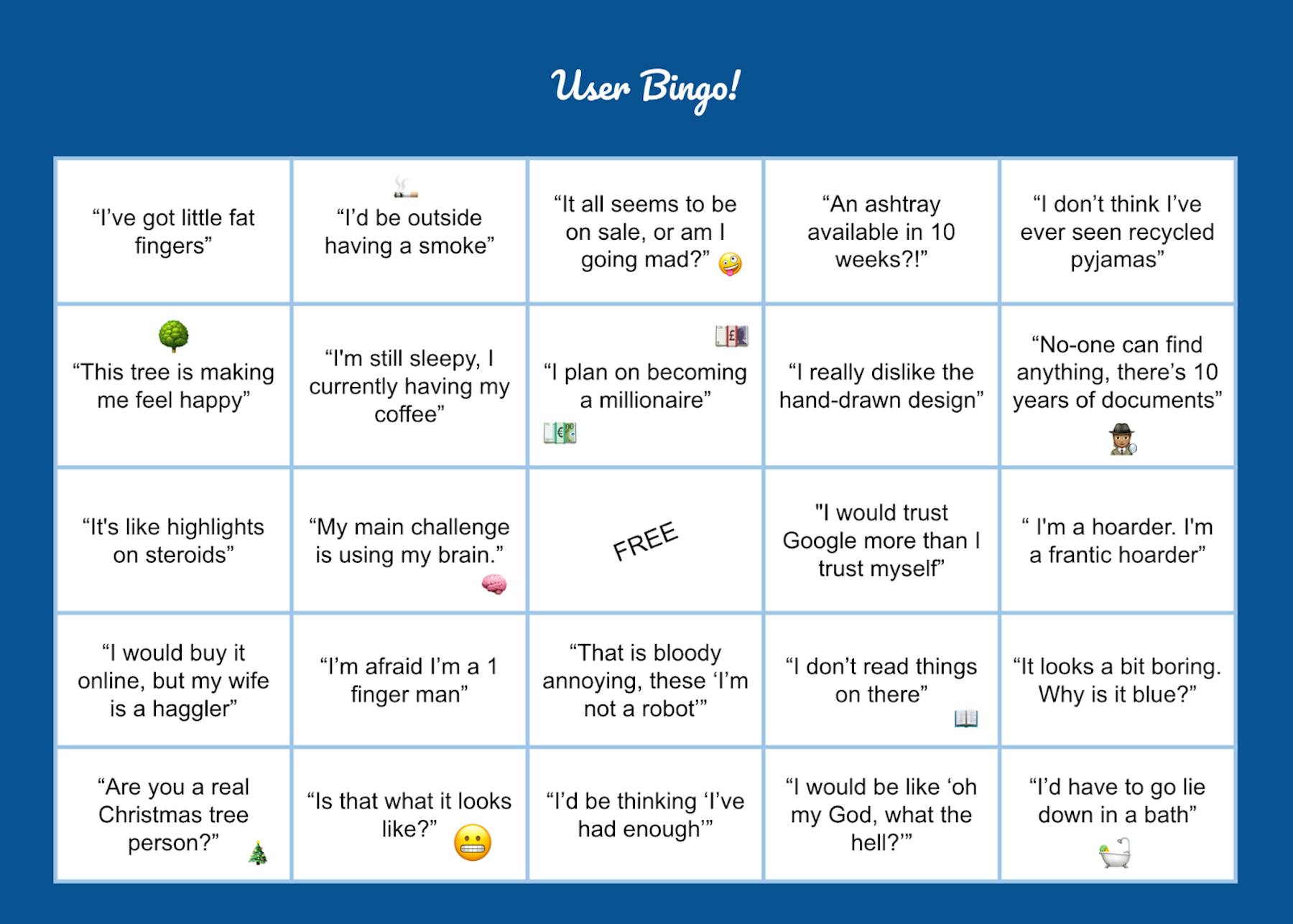
5 fun UX games to increase your user knowledge

Researchers and designers need to tell a holistic user story, based on real individuals. We need to do so in a compelling way that convinces stakeholders to trust our strategies and designs so that they can inform business decisions.
This is an enormous task. Everyone at work is busy in their own roles, so how can we build empathy for customers in a short amount of time?
Interestingly enough, there are a number of games you can play with your team to help everyone get more familiar with your users. Playing these games brings the team together, allowing you to bond over your users.
1. General trivia
Let’s start with the most simple of our games, general trivia about research and design.
Common themes are usually about topics such as users, metrics, heatmaps, and research.
You can start with simple questions (that work at both the metadata and the holistic level) such as ‘How many users have we interviewed this year?’ or ‘How many languages have we interviewed users in?’.
Don’t forget to tailor the questions to the audience, and to start easy, with questions increasing in difficulty towards the end of each theme.
You can use this opportunity to work out the weak areas in your team’s knowledge. Take note of where most people score the lowest to uncover which areas need more attention, whether analysis, reporting, or advertising.
Set-up & The Game
This format works for small or large numbers of people, using one question per slide. Say each question aloud and then provide enough time per slide for teams to read the question and discuss the answer. Split the questions by theme like ‘User interviews’, ‘Product metrics’ or ‘Team questions’.
For any questions that may be too difficult, turn them into a multiple-choice answer. This means people outside the research team can still join in with an estimated guess. Watch out, though—these games can easily overrun, so time management is key! Using a stopwatch to time each section can help add tension and increase engagement.
The trick with these questions is to balance being challenging while empowering people to feel good and learn something at the same time.
Example Questions
- How many markets do we operate in?
- How many thematic tags are there in our user research repository?
- When do you think people stop scrolling on our home page?
2. Who said it?
Did a user really say this? Why and when did it happen?
This multiple-choice quiz takes your most bizarre user quotes and downright wrong automatic transcriptions and puts your team to the test. You present a line, and teams have to guess where it came from for the point. The team with the most points at the end wins!
This game allows you to present what users say in a creative way while allowing room for fun misinterpretation - taking what was said in a unique direction.
You'll also have the opportunity to explain the context and share researcher stories at the end when going through the answers. Since this is the final part, this part should focus on the key takeaways from the activity.
Set-up & The Game
This game is best played with a medium to large group of people, split up into even teams.
Encourage a mix of roles from product, tech, and design to maximize design knowledge and team playing among disciplines. This also means that you won't end up with one team that knows all the answers.
Take quotes from your research and present one per slide. Then each team has to guess whether a quote is:
- What a user said
- An automatic transcript gone wild
- Never happened/False
Show each question for around a minute each, giving teams enough time to read the quote and discuss the answer. Don’t forget to share the context so that you continue to build empathy and understanding. You'll want your players to discuss the good, the bad, the ugly and the funny responses.
3. Quote BINGO
Another classic game to play with user quotes.
Bingo is well-known around the world with some slight differences in some countries, making it easy to play across even the most diverse and international teams. Bingo is a simple game where players mark off elements on cards, with those elements being randomly drawn by the person running the game. Each person has a different arrangement and different quotes on their cards.
Set-up and the game
For easy set-up, there are plenty of free bingo card generators online, which can be printed off for in-person games, or distributed online.
Now it’s time to call out the quotes at random until someone reaches bingo.
When calling the quotes, you can read them out loud or get creative with riddles or user stories so that people have to guess which quote was mentioned.
The creativity of how you call out each item is vital in making the game more interesting than the average game of bingo. Bingo also works with teams, allowing them to discuss the quote per riddle or story.
Players then mark off the quotes they have on their cards once called. The first person to complete a row, column, or diagonal line, wins the game.
Example
Typically bingo cards are a 5 x 5 grid with the middle tile left empty. The middle card is considered already filled. Below is our example bingo card inspired by some of our favorite quotes to get you started.

4. Never has a user…
If you’re looking for something cheeky or bold, then here is a twist on the classic party game: Never have I ever.
For this version, each person uses their fingers and thumbs as 10 points. When a user has done something mentioned or something has happened to someone in an interview, you lose a point. The last one standing with points wins the game.
Set-up and the game
The game is best played with at least five people but doesn’t require any setup in advance. Each person takes a turn to say “Never has a user…” and complete the sentence. For example; “Never has a user walked out in a session” or “Never has a user called me names”.
If the other players have experienced the statement, then they lose a point. If no one has experienced the statement, then the player who made the statement loses the point instead.
The key to this game is that players are honest about what they have experienced, no matter how embarrassing the statement is. The game should also be fun and relatable.
Try to avoid niche situations, more so at the beginning when everyone is warming up. Towards the end, the funniest and most outrageous statements are a way to show others what you’ve been through as a researcher and give you the floor to share your war stories.
5. Family Feud
Family Feud is a game in which two families (or teams) compete to guess the majority of responses in a survey consisting of everyday questions.
The fun part is that this game is less about being “right” and more about what you think the majority of people are saying or associating with a topic.
The TV show game's questions included “Name something typically done in a garage” and “What is the most stressful thing in the life of a 16-year-old?”
For research and design, the questions could be “Name the top five tasks users do on our homepage” or “What are the most stressful things our users say they go through using our products?”.
Set-up and the game
Your first step is arranging a survey to acquire a data set of questions and answers. You can use existing surveys from users or send a new one asking non-designer colleagues like developers.
You can also always use a combination of these questions and turn them into rounds like “We asked our developers to name a shopping category made popular by our users” or “We asked our Product Owners to name one of the top five most requested features by our users.” The game usually involves a survey of 100 people, but you can always use percentages instead of the number of respondents per question.
You’ll need two teams, ideally of 4-5 players each. Each team takes the place of a family in the traditional game, with one person as the ‘head of the family' or team captain. The host of the game arranges the data, asking the questions and revealing the answers.
Examples
Name a shopping category made popular by our users:
- Clothing (67% of respondents)
- Electronics (15% of respondents)
- Food & Drink (9% of respondents)
- Toys (5% of respondents)
- Beauty (4% of respondents)
Name one of the top five most requested features by our users:
- Search bar (74% of respondents)
- Filters (13% of respondents)
- Product comparison table (7% of respondents)
- Cash payment method (4% of respondents)
- Video content of products (1% of respondents)
- Share to social media (1% of respondents)
The game
The game consists of a number of rounds. Each round starts with two people from each team. The first person goes against the first person in the first round, then the second person goes against the second person in the second round, and so on.
A question is asked and the person who buzzes or answers first has the chance to win the opportunity for their team to continue. If their answer is not the top answer, the other person has a chance to answer and steal the opportunity for their team.
The team that wins the opportunity to answer is then asked the same question and tries to uncover all the answers in the survey. Teams are awarded points for every question they get right. Scoring is simple - The number of points corresponds to the number of respondents who answered. So, if 67% of people said the answer, the team was awarded 67 points. If you guess three things that aren't answers within the survey, then the other team has a chance to guess. If the other team guesses any of the remaining answers on the board, they steal your points from that round.
Each person on the opposing team says one thing they think is an answer and the captain chooses one answer as their final guess in an attempt to steal the points.
The team who wins the most points at the end of all the rounds, wins the game.
Team building through empathy
While these games use funny moments and quotes with users, there is a fine line between mockery and empathy building.
Tailor your games, questions, quotes, and delivery to your audience. These games are designed to take a serious topic and help teams learn from it by making it more light-hearted and engaging.
Quotes can and are often taken out of context. So, select quotes carefully that can be explained quickly and easily in the moment.
Games like these can help educate and engage others in research, design, and across the business—and they can also help teams to bond through sharing our vulnerabilities and mishaps.





